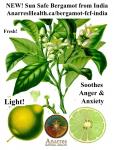Bergamot Sun Safe FCF India Essential Oil
Citrus aurantifolia bergamia Cold pressed from the crude fruit peel, from India. The “FCF” stands for “furocoumarin free” and indicates that the phototoxic constituents, known as furocoumarins, have been removed. It is therefore considered Sun-Safe.
Aroma: Very fresh, light, tangy citrus with crisp green notes and a very faint floral undertone.
History: The name Bergamot is derived from the city Bergamo in Lombardy where the oil was first sold in Europe. This tree is native to South East Asia but was introduced to Europe, particularly Italy, and is also found in the Ivory Coast, Morocco, Tunisia and Algeria.
Colour: Green/Golden
Consistency: Thin
Perfumery Note: Top
Strength of Initial Aroma: Medium
In this variety, the bergaptene content which causes photosensitivity has been removed. This allows the Bergamot to be used in skin and hair care formulations without worrying about sun exposure after use. Bergamot Bergaptene Free Essential Oil can be used to treat skin ailments such as psoriasis and eczema and it is considered to relieve stress and anxiety.
Common Uses: Bergamot essential oil can be used in the treatment of depression, stress, tension, fear, hysteria, infection (all types including skin), anorexia, psoriasis, eczema and general convalescence. This bergamot FCF is perfectly skin and sun safe.
Possible Uses: Acne, abscesses, anxiety, boils, cold sores, cystitis, depression, halitosis, itching, loss of appetite, oily skin, psoriasis, stress. [Julia Lawless, The Illustrated Encyclopedia of Essential Oils (Rockport, MA: Element Books, 1995), 56-67.] This oil is a brilliant anti-depressant! - TTF
Constituents: a-pinene, B-pinene, myrcene, limonene, B-bisabolene, linalool, linalyl acetate, nerol, neryl acetate, geraniol, geraniol acetate, a-terpineol. [B. Lawrence, "Bergamot Oil," Perfumer & Flavorist, October/November 1982, 43, cited in Salvatore Battaglia, The Complete Guide to Aromatherapy (Australia: The Perfect Potion, 1997), 145.]
Main Constituents:
Limonene: 30 - 45%
Linalyl acetate: > 20%
Linalool: > 8%
Pinene, Bergaptene, Terpineol, Nerol, Neryl Acetate, β-Bisabolene, Geraniol, Geraniol Acetate, and Myrcene.
Cautions: It may cause sensitivity in some individuals. Avoid use during pregnancy.
For information regarding the attributes of Bergamot essential oil, please see:
L'Aromathérapie Exactement, Pierre Franchomme and Dr. Daniel Pénoël, 1990, p. 338.
Essential Oils - A Handbook for Aromatherapy Practice, Jennifer Peace Rhind, 2012, pp. 211-12, 269, 286.
Aromatherapeutic Blending - Essential Oils in Synergy, Jennifer Peace Rhind, 2016, pp. 84, 126, 149, 175, 193-4.
"Bergamot: from yesterday until today," Clémence Decolin in The Osmotheque Blog, December 2016, http://www.osmotheque.fr/en/2016/12/09/bergamot-from-yesterday-until-today/
Perfume and Flavor Materials of Natural Origin, Steffen Arctander, 1960, pp. 91-4.
Photo thanks to Krzysztof Golik, CC BY-SA 4.0, via Wikimedia Commons
Essential oils and blends can most often be filled for pick up the same day, and for courier pick up the next day! My business hours are 8 am to 8 pm Sundays through Thursdays.
~~~~~~~~~~~~~~~~~~~~~~~~~~~~~~~~~~~~~~~~~~~~~~~~~~~~~~~~~~~
I carry over 500 sustainably harvested and fairly traded essential oils, resins, absolutes, extracts and dozens of enriching, infused and carrier oils, making Anarres Natural Health the most ethical and local source for essential oils in Toronto. #Essential #Oils #Toronto



